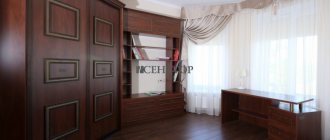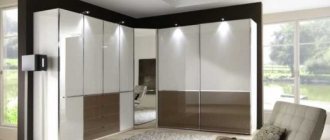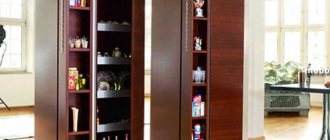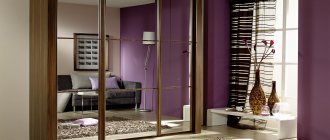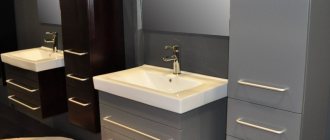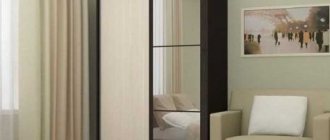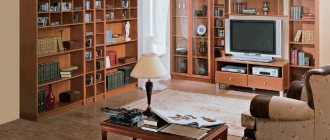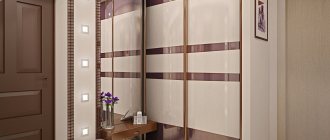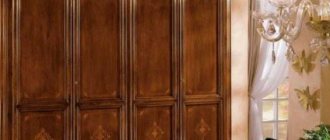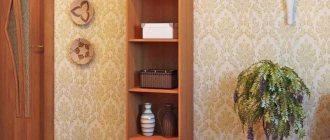21835
Owners of large personal wardrobes often do not understand how to organize the issue of storing it. If there is not enough space in the apartment to build a dressing room, you can choose an alternative. Next, you will see in the photo and tips from experienced specialists how beautiful, practical, and functional a well-chosen wardrobe can be.
Purpose
Modern furniture for residential premises is very diverse in its purpose, design, size, shape and internal content. And each family selects its own set of pieces of furniture based on its own preferences. But almost every apartment has a small or large wardrobe. It is also called wardrobe or dress. Such furniture replaced bulky chests, which were of little functionality, and is used to organize storage issues for a person’s personal wardrobe.
An original design wall with a wardrobe in the Provence style looks very attractive, allows you to place things and bring an atmosphere of comfort to your home. If you think carefully about the “filling” of your wardrobe, it will fit clothes, shoes, bags, belts, and jewelry. Many people even store sports equipment, ironing boards or bedding inside such structures.
Kinds
Let's look at the most popular types of wardrobes today to understand which model is relevant for a particular case.
According to the opening system
If you carefully study the door opening system that a wardrobe can be equipped with, they are all divided into several types:
- wardrobe with mezzanine, hinged doors. Roomy models, the height of which can reach 2.4 m, width - 1.-2 m, and depth - 0.4-0.6 m;
- compartment - even a small living room in Provence style or a bedroom with a wardrobe will be very functional, since such furniture is very compact and fits even in narrow spaces. The doors of such a cabinet move sideways along guides, since the design contains special rollers, and its depth can be varied.
Closet
Swing
By number of doors
If we consider the structure of such furniture, we can distinguish single-leaf or double-leaf options. A single door wardrobe can hold a lot of things; the design has only one door, which swings outwards. In the second version, the closet has two doors, but they can be not only hinged, but also compartment doors.
You can also choose a model with three doors, where two of them are compartments, and the third is a hinged one. Often, such models have a hinged door that hides drawers and shelves, and behind the compartment doors there is a large space with a crossbar and hangers on it.
According to the material of manufacture
Nowadays, furniture is made from a wide variety of materials, but buyers are increasingly giving preference to the following types:
- made of solid wood (pine, alder, oak, etc.). As practice has shown for many years, a wardrobe made of solid natural wood is the most durable, practical and respectable option. It is distinguished by the maximum level of naturalness, resistance to wear, looks expensive, and has a natural smell of wood (pine gives a particularly pleasant smell). The only thing that can scare off buyers is the high cost of a wardrobe made of solid wood in the Provence style, because it is classified not as a “standard” class, but as an “elite” one;
- MDF - a wardrobe made of MDF has a varied design, since the material is made in a wide range of colors, patterns, and textures. MDF goes well with glass and chrome elements, so furniture made from this material often has original decor. The operational parameters of such structures are above average, and the service life is quite long;
- Chipboard - this material is affordable and has average resistance to negative environmental factors. Chipboard swells with prolonged exposure to water, can fade with prolonged contact with direct sunlight, it is difficult to remove children's markers from its surface, and does not absorb the smell of food. However, a children's wardrobe is the most profitable purchase for a baby. It is used to make standard models that are highly economical. As a child grows, his needs and wardrobe change, so within two to three years after purchasing a wardrobe, it may no longer be needed. Due to the low cost of chipboard models, they are the ones that parents prefer more often than others.
Wood
Chipboard
MDF
By accommodation option
The installation location of the wardrobe will determine the features of its contents, main parameters, and external aesthetics:
- corridor - for a narrow space, you need a compact wardrobe, with compartment doors, preferably in a light color, but not black. The optimal models are those with a depth of 40-60 cm in a light color. The product can be installed opposite the entrance door if the corridor has a square shape, or near it if the entrance group has an elongated shape;
- the bedroom is the optimal space for installing a wardrobe, because this is where a person chooses an outfit for leaving the house;
- living room - if there is no space in the bedroom, you can install a locker with clothes in the living room. It’s good if it is part of the wall or complemented with racks, shelves, or a TV stand. Such a furniture composition will look very holistic and harmonious;
- children's room - lockers for children's clothes can be compact and bright in design. The optimal type of wood from which such furniture is made is pine. It is better to install them on a free wall and additionally secure them with fasteners, which will avoid the risk of injury to the child. Drawers should also be selected with a fall-out protection system.
Dimensions
Today, the furniture market offers wardrobes of various sizes - from small (narrow or low) designed for small spaces to huge combined wardrobes with a large number of compartments.
Basic wardrobe dimensions:
- The width of the wardrobe depends on the number of doors and is at least 0.4 m for a single-leaf wardrobe (to fit boxes of shoes), optimally 0.6 m; 1-1.6 m for a double-door wardrobe; 1.5–2.4 m – for tricuspid. The door width is 0.6-0.8 m.
- The number of doors is determined by the number of sections. Serial models have the following parameters: 2-3 doors and width 1-2.4 m. Such a closet can accommodate a sufficient number of things that can be placed on shelves in two rows, and the hanging storage compartment can accommodate the clothes of almost all family members;
- The standard depth of a classic wardrobe is 0.6 m, but narrower models are also produced (0.45 m). With a normal cabinet depth, hanger bars are placed along the back wall, and with a reduced depth, perpendicular to it;
- The height of serial cabinets is 2.2-2.4 m. But low models are also produced - 1.7-1.8 m;
The classic wardrobe is installed on a plinth, thanks to which the furniture can easily be moved to the wall with a plinth. Stylized wardrobes are made on legs.
Main areas
To make the furniture ergonomic, it is worth highlighting several zones in the wardrobe.
| Zones | Options | Filling |
| Lower | Up to 0.8 m from the floor | Here you can store rare items, if there are drawers - underwear, socks. Also, if it is not possible to store shoes in the hallway, the lower area of the wardrobe can be reserved for this purpose. In this case, each pair of shoes should be thoroughly washed, dried, and put in a box. |
| Average | 0.8-1.8 m from the floor | Things that people constantly need are stored here. Place shelves in the middle zone for various kinds of things. If they are part of the structure, that is, stationary, the cabinet will be able to withstand more significant loads. If the shelves are removable, then it is better to store things that are not too heavy on them. The optimal width of the shelves is 60 cm, and the distance between them is 40-45 cm. |
| Upper | Above 1.9 m | This is a good place to store hats, umbrellas, bags, scarves and gloves. That is, light things that a person needs from time to time. |
“Standard” models have a fairly simple content, while products in the “elite” category can be equipped with expensive storage systems, drawers for unified clothing, so more zones can be allocated in them.
Internal filling
According to the canons of ergonomics, the wardrobe is divided into three tiers:
- lower level - its height is up to 0.8 m;
- middle platform - 60-190 cm;
- the upper zone occupies from 1.9 m.
Advantages of a cabinet with louvered doors, proper placement of furniture
There are two types of things stored below. If the wardrobe is in the bedroom, bed linen is placed in the drawers. When installed in the hallway, shoes are stored on the shelves.
The middle tier is designed for constantly used clothing and accessories. The following elements are located there:
- Barbells. If the depth of the wardrobe is standard (0.6 m), the pipe with hangers is placed parallel to the back wall. When it is narrow (0.4 m), an end holder is used, attached to the sides. The kit often includes short rods - skirts, trousers.
- Shelves. It is recommended to do them at eye level. This way you can quickly find the thing you need. They store any things. Systems can be permanent or removable. The standard step between them is 0.3-0.4 m.
- Boxes. They are made roll-out, retractable, equipped with closers. For better viewing, transparent boxes or mesh baskets are used. They store shirts, T-shirts, underwear and bed linen. Boxes with cells are often used. Ties, straps, gloves and other accessories are placed there.
Types of modern cabinets, placement tips from designers
The upper level of the cabinet is equipped with shelves or mezzanines. They store periodically used items, for example, hats, seasonal, sportswear.
Required elements
Each wardrobe has mandatory and additional elements. The first include shelves placed one above the other. They are convenient for storing small items for frequent use (T-shirts, tank tops, trousers, sportswear). Also a mandatory element of such furniture is an area with a horizontal crossbar with hangers. They store outerwear and dresses.
Expensive models may have specific storage systems for a certain type of clothing: sportswear, shirts, trousers, jackets, and so on.
Style and form
Modern designers use wardrobes to decorate bedrooms in different stylistic directions. The most relevant cabinets are in the style:
- classic style - for this type of decor of residential premises it is worth choosing huge, massive and solid cabinets in a classic style with an unusual finish, made of solid wood. Models should be decorated with large inlays, stained glass inserts, paintings, and textured patterns on the front doors. Such decor allows you to make your wardrobe chic, representative, and stylish. It looks especially stylish when things are folded in a white wardrobe, an option in wenge or mahogany in a classic interior;
- in Provence style - for an interior in Provence style you will need a wardrobe made of natural wood with curly legs and a surface with an antique effect, hinged doors. The color scheme of the models should be light, natural in tone;
- in country style - choose wooden models. An excellent option would be pine, which gives a natural smell. The color of the furniture should not be too dark, but not too light, in order to successfully complement the interior in a rustic style;
- in the loft style - a wardrobe with a laconic look, hidden fittings, by the way, would be perfect in a loft living room.
Styles and colors
When choosing a wardrobe, you need to decide on its design. It depends on the size and design of the room. It is important to take into account the inherent tonal palette of the room. Features of different designs:
- A wardrobe in a classic style (Baroque, Rococo, Empire style) is suitable for spacious and richly furnished rooms. It is made from natural wood. Furniture in all its natural tones and textures is common. A white cabinet with carved gold and silver decor is also traditional for the classics.
- Constructivism and minimalism are characterized by simplicity of geometry, laconic lines, lack of decor, and calm colors of furniture. The styles combine rationalism, logic, functionality, and comfort in everything. Common directional tones: white, black, light yellow, green, pale blue.
- Furniture in the Provence style is characterized by simplicity, elegance of shapes and lines, and naturalness of the materials used. The design is characterized by all the colors that are found in nature in the coastal south of France: white, blue, yellow, green, lavender, lilac, light green, pink. The furniture is made from solid wood and is often decorated with laconic carved decor.
- High-tech refers to modern trends. Wardrobes in this style are made of MDF, chipboard, plexiglass, glass, and metal. The furniture is characterized by straight, sharp shapes and lines, and simple decor. The design uses light colors, silver, and steel metallic.
- Roughly processed timber and planks, knocked together into a simple design - this is what country-style furniture looks like. The facade of a rustic cabinet is often decorated with laconic carvings. All natural colors found in nature are popular.
- The loft imitates the atmosphere of abandoned industrial premises and attics. Furniture in his aesthetic should be rough, massive, straightforward, similar to industrial equipment. Recommended colors: brown, sand, yellow, green, brick, metallic. The style allows for the wardrobe to be made from steel or warehouse pallets.
The colors of the furniture and room decoration should be harmoniously combined with each other. In this case, you cannot use more than three tones, otherwise the design of the room will be colorful and flashy.
Selection rules
If the layout of the room includes a niche, an excellent solution would be to organize a wardrobe inside it with sliding doors. The dimensions of the compartment can be very varied: height is 1.5-2.4 m, depth 0.4-0.6 m, width 1-2 m. Models of hinged wardrobes are relevant for spacious rooms, because when swinging the door open it requires sufficient space . You can’t put such a wardrobe in a narrow corridor or a tiny bedroom.
Wooden furniture looks the best in conservative classics. And what does it smell like? For example, pine and other species smell very good. To save money without compromising the aesthetics of the furniture, you can combine chipboard with MDF to make a wardrobe. The following photo shows such a model with a large facade.
Varieties
The wardrobe serves for the careful preservation of street and home clothes, hats, shoes, and accessories. It reliably protects things from dust, dirt, as well as fading and damage by insects (for example, moths). The shape of the furniture is selected based on the configuration of the room:
- Linear cabinet. It can be rectangular or square. Suitable for spacious rooms of the same shape. Placed close to one of the walls. There are narrow structures with a depth of 0.35–0.4 m. They can be used to equip narrow rooms.
- Corner wardrobe. Suitable for small square or irregularly shaped rooms. Furniture located at the junction of two walls will free up space in the room. Designs are divided into the following types: L-shaped and diagonal. The first occupy the corner of the room and two adjacent walls. This type is the most common. The second ones have a triangular configuration, located in the same way as L-shaped ones.
- Radius (semicircular) furniture. It has significant depth. Placed along the wall or in the corner of the room.
There are three subtypes of radius cabinets:
- convex models - most often built into niches;
- concave analogues are hull structures;
- wave-shaped furniture - combines compartments of the first two configurations.
Linear
Angular
Radius
The described furniture may have 1-6 doors. Their number depends on the dimensions, content, and functionality of the cabinet. Its design is also important. Single-leaf structures are most often made narrow, 0.3 m wide, and high. They are often called pencil cases. The furniture is divided into several vertical compartments with separate doors located one above the other. A rod with hangers is mounted in the upper section; shelves and roll-out drawers are located below.
Double-leaf structures are made with legs or placed directly on the floor. The width of the furniture is from 0.5 m, the depth is 0.5-0.6 m. Three-door cabinets are divided into two compartments. The larger one (with two doors) houses a bar with clothes hangers. The smaller section houses shelves and drawers.
Four-leaf cabinets are spacious and stable, so they are often made with a mezzanine or an additional shelf. Placed in spacious rooms. A design with 5-6 doors completely occupies one side of the room. This wall is universal; you can store clothes, personal items, dishes, books, and household appliances in it.
Classification of shelving cabinets, functional design features
Furniture doors open in different ways. Hinged cabinets are the most common. Their hinged doors open towards themselves and require additional space. Folding doors of the “accordion” and “book” type make it possible to see all the contents of the wardrobe at once. Best suited for corner furniture, saving room space. Sliding wardrobes are equipped with sliding panels on roller guides. They move left and right, thereby freeing up space in the room.
Cabinet furniture always has walls, a bottom, a lid, and a front with doors. Small models are equipped with legs, so they can be moved. Stationary structures are placed directly on the floor.
Swing
Coupe
Harmonic
